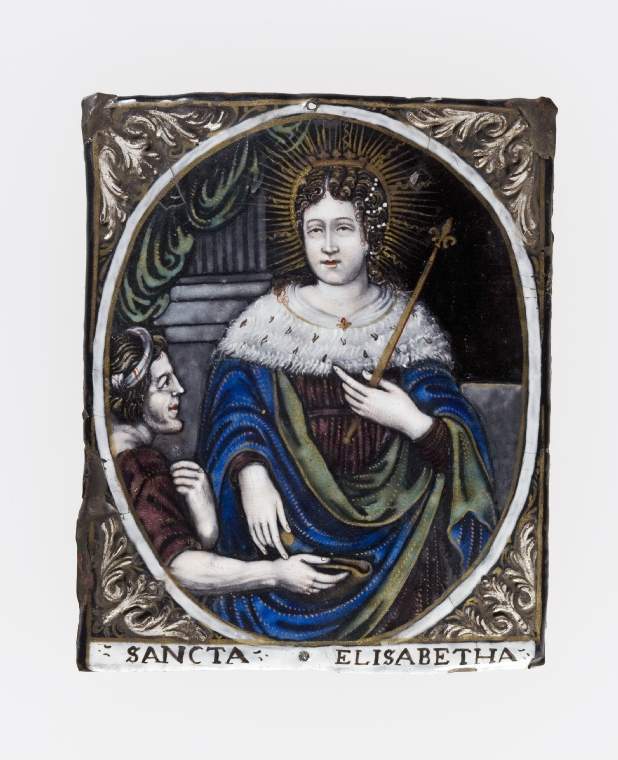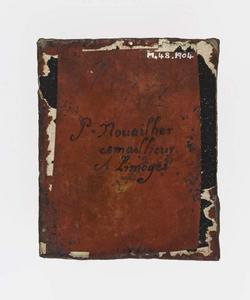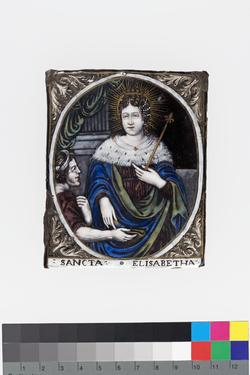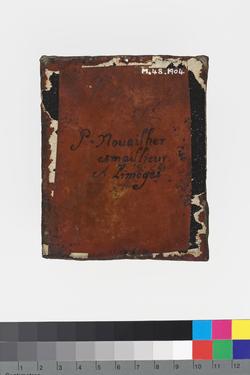Current Location: In storage
Titles
St Elizabeth giving Alms to a Beggar
Maker(s)
Maker:
Nouailher, Pierre, l'aisné
(Probably)
Maker:
Nouailher, Pierre, II
Entities
Categories
Description
Rectangular copper plaque painted in polychrome enamels and gilded. St Elizabeth giving alms to a beggar, titled below 'SANCTA.ELISABETHA'; white relief foliage and gold foliage on a black ground in the spandrels.
Rectangular, slightly convex copper plaque with a small hole at top centre and at bottom centre, and an inward curve to the left side, enamelled in blue, green, pink, red, brown, mulberry, grey, black, and white, and gilded. The counter-enamel is clear but appears uneven dark red. An oval medallion with a white and gold frame encloses a three-quarter length figure of St Elisabeth giving alms to a beggar. The Saint has a gold crown which forms part of her halo. Her dark brown hair has a centre parting and is ornamented on her left side with three rows of white pearls. Over a pleated mulberry dress, she wears a dark blue cloak with a green lining, and an ermine collar. The folds of the fabric are highlighted by small gold dashes. In her left hand she holds a gold sceptre terminating in a fleur-de-lys, and with her right is about to place a coin into the hat of a beggar approaching from her right. Only the upper part of his body is shown. His right arm is outstretched holding his hat, and his left hand is close to his chest. He wears a mulberry tunic, and a white and red cloth wound round his head. Behind him is a column and a green curtain. Both figures have red fingernails and shading on their hands. The spandrels outside the frame have a black ground decorated with gold foliage, and white foliage in relief. Across the bottom of the plaque is a narrow white label inscribed in black ‘: SANCTA • ELISABETHA’. On the back in black, ‘P. Novailher/esmaillieur/A Limoges’
Notes
History note: Not lot 247 in the Magniac Collection sale as stated by Dalton, 1912. Edwin H. Lawrence, FSA (1819-91); Christie’s, 4-6 May 1892, 2nd day, second part of lot 168; Frank McClean, MA, FRS (1837–1904) ; bequeathed by him
Legal notes
Frank McClean Bequest
Measurements and weight
Height: 10.4 cm
Width: 8.5 cm
Acquisition and important dates
Method of acquisition: Bequeathed
(1904)
by
McClean, Frank
Dating
17th Century, Late-18th Century, Early
Circa
1690
CE
-
1710
CE
Note
St Elizabeth of Hungary was born in 1207, traditionally at Sàrospatak. At the age of fourteen she married Ludwig IV, Landgrave of Thuringia with whom she lived happily until he embarked on the Sixth Crusade, and died at Otranto in Italy in 1227. Elizabeth refused to remarry, and moved to Marburg, where she may have become a tertiary of the Fransiscan order. She founded a hospital, and continued the charitable good works for which she had become famous during her marriage. She died in 1531, and was canonized in 1235 by Gregory IX, and made patroness of the Third Order of St Francis.. Her bones were translated to the church of St Elizabeth at Marburg, which became a pilgrimage centre. In 1539 the Lutheran Landgrave Philip of Hesse had her bones removed to an unknown situation to prevent superstitious practices. She became a popular saint, and depictions of her giving alms occur on plaques, holy water stoups, and reliquary frames (frames with several small relics mounted within them)
Rectangular plaques decorated with oval portrait medallions and spandels decorated in relief with stylized foliage, usually in white with gilding on a black ground came into fashion in the second half of the seventeenth century and continued into the early eighteenth. Relief decoration is also found on two-handled bowls, candlesticks, ewers, and purse plaques.
This plaque was probably made by Pierre Nouaillier, l'aisné (c. 1657-1717), or his younger brother, Pierre II Nouailher (1665-after 1743). The format and style is similar to others with portraits of Christ, the Virgin, or Saints usually attributed to Pierre II Nouailher, and the signature on the back is similar to that on the reverse of a plaque of St Simon, in the Musée des Beaux-Arts, Limoges. His treatment of the facial features, and the halos with wavy rays alternating with groups of shorter straight rays was distinctive, and can be seen on many other plaques. The quality seems inferior to enamels attributed to Pierre I Nouailher, such as the bowl of a cup signed 'P. NOVALHER. ESMAILLEIVR’ in the Walters Art Gallery, or three two-handled cups in the Louvre. But the dark colouring suggests that it was made before about 1720, as the colouring of painted enamels became brighter and paler towards the middle of the century.
School or Style
Baroque
People, subjects and objects depicted
Components of the work
Decoration
composed of
enamel
( blue, green, pink, red, brown, mulberry, grey, black, and white)
gold
Plaque
composed of
copper
Inscription or legends present
- Text: SANCTA.ELISABETHA
- Location: On front of plaque at bottom
- Method of creation: Painted in black enamel
- Type: Inscription
- Text: P. Novailher/esmaillieur/A Limoges
- Location: On back
- Method of creation: Painted in black enamel
- Type: Signature
- Text: Pi ?/S/1/ [1 raised over horizontal line]
- Location: On back near the top
- Method of creation: Hand-written in black
- Type: Inscription
References and bibliographic entries
-
Fitzwilliam Museum, McClean Bequest, Catalogue of the Mediaeval Ivories, Enamels, Jewellery, Gems and Miscellaneous Objects Bequeathed to the Museum by Frank McClean, M.A., F.R.S.
page(s): 115
-
The Oxford Dictionary of Saints
page(s): 155-6
-
The Walters Art Gallery, Catalogue of the Painted Enamels of the Renaissance
page(s): 348-0
-
Les émaux peints de Limoges. Musée du Louvre, Département des objets d'art
page(s): 415
-
Le métier d’émailleur à Limoges, XVIe-XVIIe siècle
page(s): 400
-
La Rencontre des Héros, Regards croisées sur les émaux peints de la Renaissance appartenant aux collections du Petit Palais, Musée des Beaux-Arts de la ville de Paris et du Musée municipal de L'Évêché de Limoges
page(s): 222-224
Identification numbers
Accession number: M.48-1904
Primary reference Number: 156434
Stable URI
Audit data
Created: Saturday 6 August 2011
Updated: Monday 25 March 2024
Last processed: Wednesday 17 December 2025
Associated departments & institutions
Owner or interested party:
The Fitzwilliam Museum
Associated department:
Applied Arts

 IIIF Manifest
IIIF Manifest






